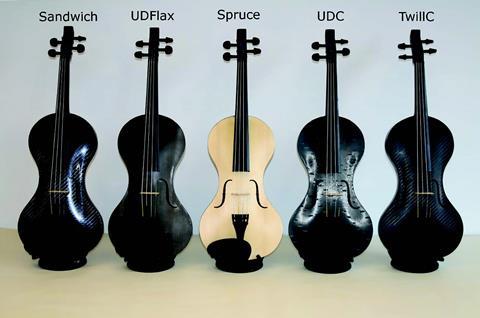The research has been published in the Journal of the Acoustical Society of America

A new study has investigated the different sound properties of composite materials, and how listeners perceive them. Six violins were constructed using identical design and construction methods, the only difference being the material used for the soundboard. In a double-blind test in a concert-hall setting, a group of 37 experienced listeners were then asked to listen to all six violins and give their opinions on the sound of each one. The results were published in the Journal of the Acoustical Society of America on 28 April
Only one violin was given a top made from spruce. The other materials were:
- UDFlax: unidirectional flax fiber reinforced polymer
- UDC: unidirectional carbon fiber reinforced polymer
- Sandwich: sandwich structure consisting of CFRP skin and an aramid honeycomb core
- TwillC: laminate of twill woven and unidirectional carbon fiber reinforced polymer
Two violins were given a TwillC soundboard (‘TwillCA’ and ‘TwillCB’) ‘to check the consistency of the influence of the material and production methods on the sound of the violin’. The listening test took place in a 98-seat concert hall at the Royal Conservatory of Ghent. However, as noted in the paper, ’The musician, the acoustics of the hall, and the procedure of the evaluation experiment surely affected the results…which makes the interpretation of the results more difficult and limits the possibility to draw conclusions.’
Consequently, a second experiement comparing three of the violins (along with one conventional violin as a control) was performed at the 200-seat Trechterzaal hall at Ghent University, in front of 40 listeners, all members of the Ghent University Orchestra. As well as giving their preferences of each instrument, each listener was asked to give one of three reasons: ‘better projection’, ‘better balance’ or ‘better sound colour’. Mostly, the listeners gave ‘better sound colour’ as the reason for their preference. They were then asked to choose from a number of adjectives which one best described the sound colour of each insrument. The table below shows the results.

The study found that ’UDFlax’ was described most as warm and round, ‘TwillCB’ as clear and open, and ‘Sandwich’ most as powerful, bright and rich, and least as warm.
Read: New materials: Comparing violin tops made from various composites
View: Gallery: A violin made out of shredded money
Watch: Making a cello from carbon
In the conclusion, the authors stated: ’Our experiments show that by using a variety of composite materials for soundboards of violins, a wide range of sounds and timbres can be produced. As the use of these composite materials allow violin makers to change the sound of a violin in a number of ways, they can offer new artistic opportunities for violin players and composers to explore.’
The two violins with soundboards of identical material - TwillCA and TwillCB - received very different results from the listeners. ’More research is needed to understand what causes these differences,’ the researchers acknowledged. ’When we examine the scores of TwillCA(1) and TwillCA(2) we observe some differences in attributes that are linked to loudness like powerful or loud. A possible explanation for this finding is that TwillCA(2) was presented after UDFlax, the least powerful and loud instrument. As the listeners had just heard UDFlax, they rated TwillCA(2) in relation to this, resulting in a different score in adjectives related to projection. As TwillCA(1) was the first violin played, it could have been affected by the order in which the instruments were presented.’
The full study can be viewed for free here











































1 Readers' comment